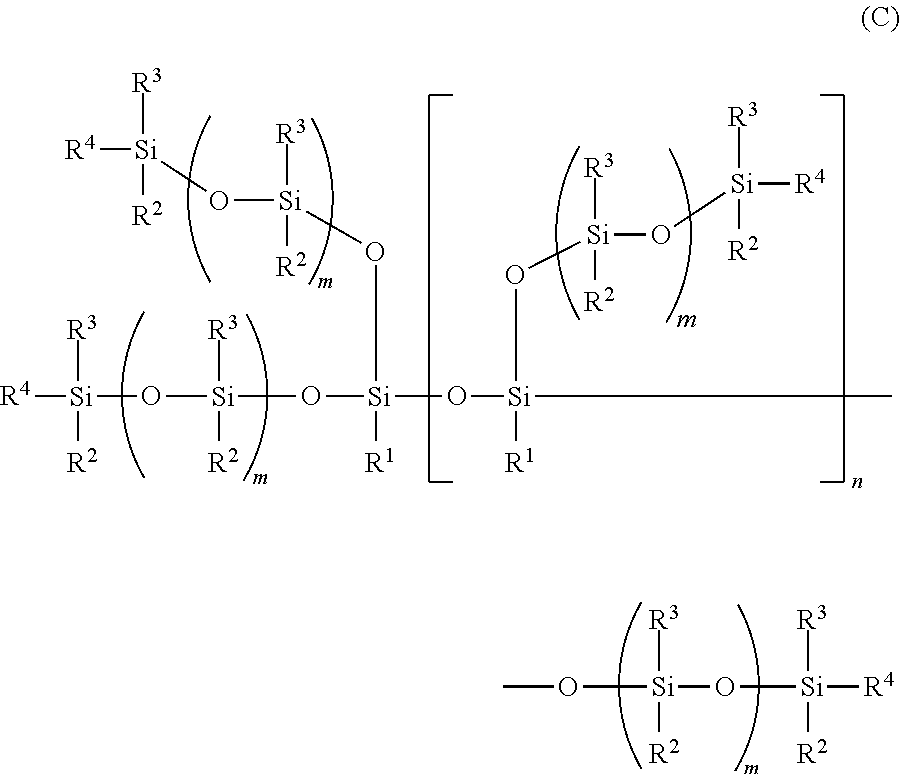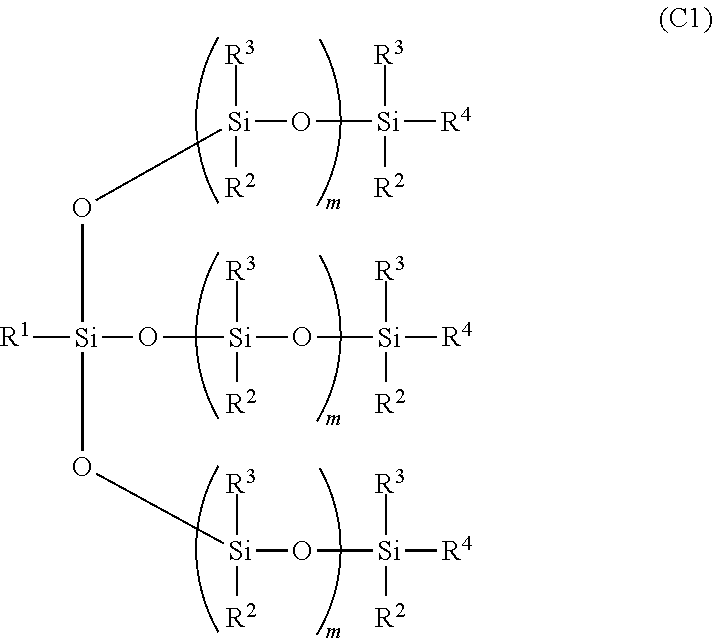Composition for ultrasonic probe, and silicone resin for ultrasonic probe
a silicone resin and ultrasonic probe technology, applied in ultrasonic/sonic/infrasonic diagnostics, instruments, applications, etc., can solve the problems of increasing reducing the number of cross-linking points, and increasing the ultrasonic attenuation. , to achieve the effect of improving the hardness and mechanical strength of the resin, reducing the number of cross-linking points, and improving the hardness and mechanical strength
- Summary
- Abstract
- Description
- Claims
- Application Information
AI Technical Summary
Benefits of technology
Problems solved by technology
Method used
Image
Examples
example 1
[0137]88 parts by mass of a vinyl-terminated polydimethylsiloxane (kinematic viscosity of 0.1 m2 / s, manufactured by GELEST, INC., “DMS-V51”), 2 parts by mass of a methylhydrosiloxane-dimethylsiloxane copolymer (molecular weight of 2,000, methylhydrosiloxane proportion of 27 mol %, manufactured by GELEST, INC., “HMS-301”), 10 parts by mass of a branched vinyl-terminated branched polydimethylsiloxane (manufactured by GELEST, INC., “MTV-112”), and 20 parts by mass of fumed silica (manufactured by NIPPON AEROSIL CO., LTD., “AEROSIL R974”) were kneaded for 2 hours using a kneader to make homogeneous paste. 500 ppm of a platinum catalyst solution (manufactured by GELEST, INC., “SIP6821.3”) was added to and mixed with the paste. The mixed paste was defoamed under reduced pressure and was placed in a 150 mm×150 mm metal mold. Heat treatment was performed thereon for 15 minutes at 150° C. to obtain resin sheets each having a thickness of 1 mm, 2 mm, and 3 mm.
example 2
[0138]83 parts by mass of a vinyl-terminated polydimethylsiloxane (manufactured by GELEST, INC., “VQM-146”) which contains 23 mass % of a vinyl group-containing silicone resin, 7 parts by mass of a methylhydrosiloxane-dimethylsiloxane copolymer (molecular weight of 2,000, methylhydrosiloxane proportion of 27 mol %, manufactured by GELEST, INC., “HMS-301”), 10 parts by mass of a branched vinyl-terminated branched polydimethylsiloxane (manufactured by GELEST, INC., “MTV-112”), and 5 parts by mass of fumed silica (manufactured by NIPPON AEROSIL CO., LTD., “AEROSIL R974”) were mixed with each other in the same manner as in Example 1, and the mixture was thermally cured using the same platinum catalyst solution as that in Example 1 to obtain a predetermined resin sheet.
example 3
[0139]89 parts by mass of a vinyl-terminated polydimethylsiloxane (kinematic viscosity of 0.165 m2 / s, manufactured by GELEST, INC., “DMS-V52”), 1 part by mass of a methylhydrosiloxane-dimethylsiloxane copolymer (molecular weight of 1,000, methylhydrosiloxane proportion of 53 mol %, manufactured by GELEST, INC., “HMS-501”), 10 parts by mass of a branched vinyl-terminated branched polydimethylsiloxane (manufactured by GELEST, INC., “MTV-112”), and 20 parts by mass of fumed silica (manufactured by NIPPON AEROSIL CO., LTD., “AEROSIL R974”) were mixed with each other in the same manner as in Example 1, and the mixture was thermally cured using the same platinum catalyst solution as that in Example 1 to obtain a predetermined resin sheet.
PUM
| Property | Measurement | Unit |
|---|---|---|
| Percent by mass | aaaaa | aaaaa |
| Percent by mass | aaaaa | aaaaa |
| Percent by mass | aaaaa | aaaaa |
Abstract
Description
Claims
Application Information
 Login to View More
Login to View More - R&D
- Intellectual Property
- Life Sciences
- Materials
- Tech Scout
- Unparalleled Data Quality
- Higher Quality Content
- 60% Fewer Hallucinations
Browse by: Latest US Patents, China's latest patents, Technical Efficacy Thesaurus, Application Domain, Technology Topic, Popular Technical Reports.
© 2025 PatSnap. All rights reserved.Legal|Privacy policy|Modern Slavery Act Transparency Statement|Sitemap|About US| Contact US: help@patsnap.com



